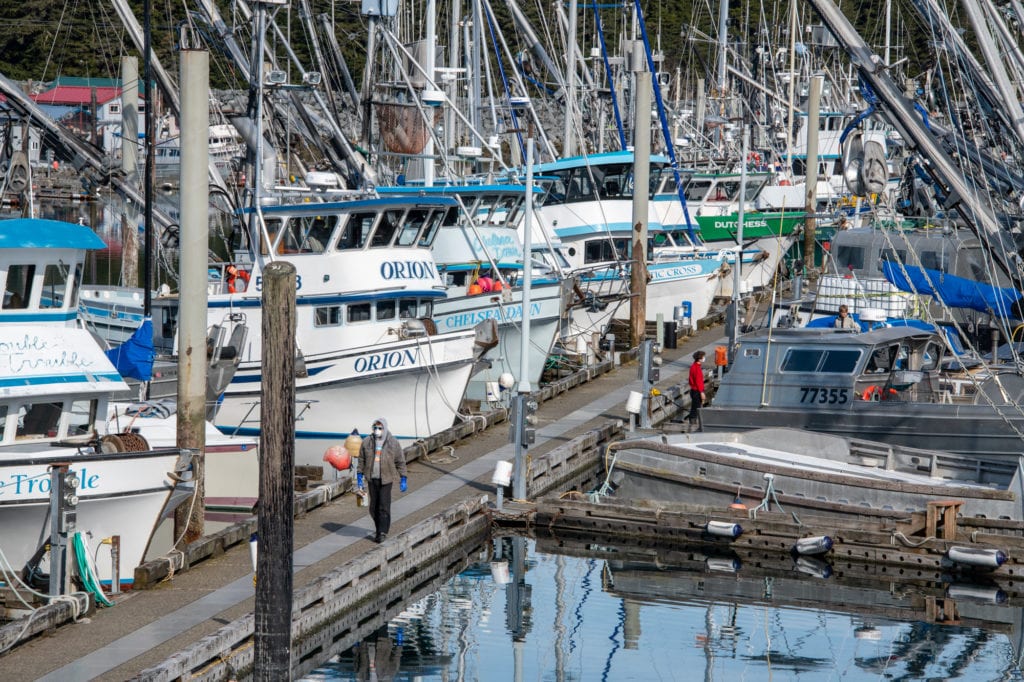
Commercial salmon harvesters had a challenging year in Prince William Sound, with the abundance of fish and the estimated value well below average, state fisheries officials confirmed in their season summary.
As noted by Alaska Department of Fish and Game biologists Jeremy Botz and Charlie Russell in their report from ADF&G’s Cordova office, the estimated value of the salmon harvest commercial and hatchery cost recovery for 2020 was approximately $49.64 million, 57 percent less than the 10-year average of $115.05 million.
During the 2020 commercial season, 489 drift gillnet, 26 set gillnet and 219 purse seine commercial permit holders fished in at last one fishing period. The drift gillnet vessel harvest value of $10.01 million was less than one-quarter of the 10-year average, the lowest since 1980. Per permit earnings on average were $20,500, compared to the 10-year average of $84,400.
Set gillnet ex-vessel harvest value was an estimated $872,300, with average permit earnings of $33,500, compared with the 10-year average of $89,200, and purse seine ex-vessel harvest aue was an estimated $22.72 million, with average permit earnings of $103,800, compared with a 10-year average of $251,900.
Revenue generated by hatchery operation came to about $16.03 million, the report said.
The 2020 Prince William Sound area commercial and hatchery cost recovery salmon harvest came to 25.51 million fish, including 7,000 Chinook, 956,400 sockeye, 273,900 coho, 22.27 million pink and 2.01 million chum salmon. Some 20.33 million fish, or 80 percent, were part of the commercial harvest, with 20 percent, or 5.19 million salmon part of the hatchery cost recovery and broodstock.
The preseason forecast for the Copper River District gillnet harvest was 771,000 sockeye and 223,000 cohos, plus the common property king salmon forecast of 36,000 fish. The Gulkana Hatchery total run was projected at 109,000 sockeyes. The Copper River then experienced one of the weakest sockeye runs on record, with little fishing opportunity and the third smallest commercial harvest in half a century.
The sockeye commercial harvest of 98,300 fish was 92 percent less than the 10-year harvest average of 1.31 million fish. The sockeye season in fact, was open for all of 84 hours, compared with 648 hours last year, during a near average sockeye run. The sockeyes harvested weighed an average of 5.1 pounds, equal to the record small size seen in 2018, and 0.8 pounds smaller than the 30-year average (1990-2019) of 5.9 pounds.
The number of wild sockeyes in the Copper River District commercial harvest was 91,900, or 94 percent of the total.
The Gulkana Hatchery commercial harvest was the lowest since 1984, with 5,713 red salmon contributed to the overall commercial harvest. Main Bay Hatchery had 700 sockeyes, or about 1 percent of the Copper River sockeye harvest.
The commercial harvest of 5,900 kings was the smallest commercial harvest since statehood and 56 percent below the 10-year average harvest of 13,400 fish.
The preliminary Mile Lake sonar passage estimate of 530,300 salmon was below the in-river goal of 661,000 to 1,050,000 fish. Still the Copper River sockeye escapement goal was likely met, the report said.
In the purse seine fisheries, the chum salmon run forecast was 4.46 million fish, with an estimated commercial harvest of 2.97 million.
The majority of the total run, 3.86 million or 87 percent of the fish were from the Prince William Sound Aquaculture Corp. hatchery production, with 500,000 fish returning to the Armin F. Koernig (AFK) hatchery and 810,000 fish returning to Port Chalmers subdistrict purse seine fisheries.
Based on ADF&G’s wild stock chum salmon forecast of 604,000 fish there was a potential commercial harvest of 404,000 wild chums.
The chum salmon commercial harvest in Prince William Sound came to 1.20 million fish, or 1.77 million (60 percent) below the preseason harvest forecast. The commercial purse seine fleet brought in 892,000 chums in 2020, including approximately 195,900 AFK chums harvested in the commercial fishery. That catch was 61 percent below the preseason forecast of 500,000 fish. The state report also noted that 17,700 sockeyes were harvested in the AFK commercial chum fishery. The Montague District chum commercial harvest was 607,300 fish.
The pink salmon commercial run forecast was 33.64 million fish, including 14.62 million Valdez Fisheries Development Association (VFDA) hatchery fish, 14.60 million PWSAC hatchery fish and 4.42 million wild fish. That compared with the commercial harvest of 18.15 million humpies, which was 31 percent below the 26.10 million commercial harvest forecast, primarily due to low returns to all hatcheries, the report said.
This year’s VFDA enhanced coho forecast was 82,300 fish, with a forecasted commercial harvest of 24,600 fish. The report notes that the total commercial purse seine harvest for cohos was 30,000 fish, including 19,000 in the eastern district.





